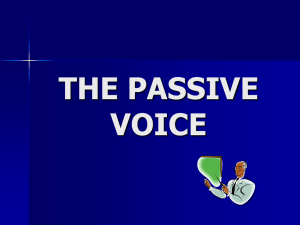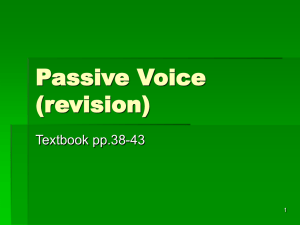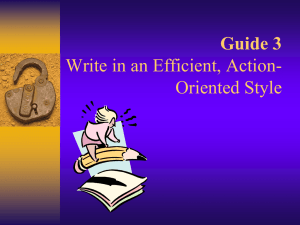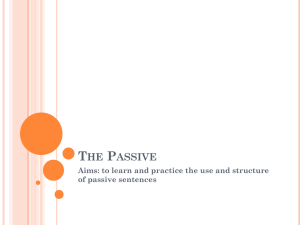The Passive Voice
advertisement
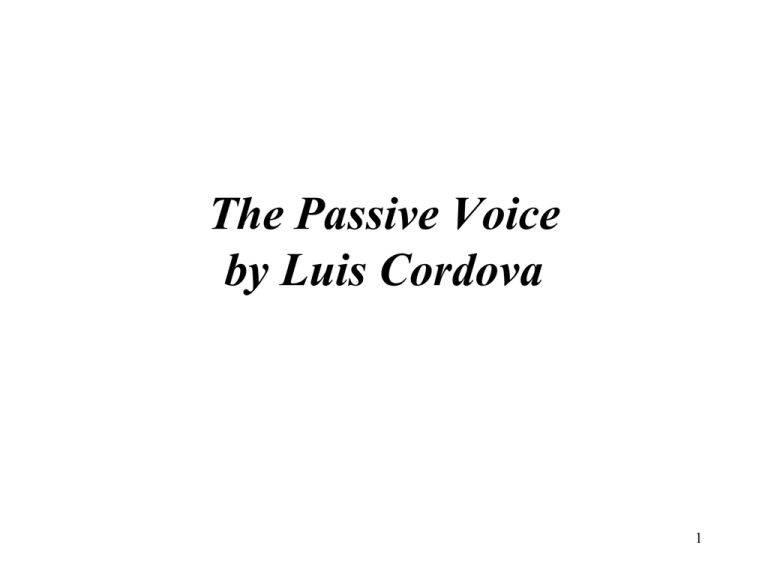
The Passive Voice by Luis Cordova 1 Contents 1. 2. 3. 4. 5. 6. 7. 8. Introduction to the Passive voice the passive with tense and aspect Other passive verbs When to use the Passive Semantic Constraints on Using the Passive Meaning difference between the active and passive Adjective or Passive? A Middle Voice 2 Introduction to the Passive Voice In the passive voice, the receiver of the action (object) is put in the subject position. O Be Past P S Ex: The ball was thrown by Luis. This differs from its active voice counter part, where the subject is the direct doer of an action. S V O Ex: Luis threw the ball. There are two unique features that distinguish a passive from an active sentence: 1. The passive consists of a “be” verb + past participle (-ed, -en, and irregular verbs) 2. The passive consists of a “by” phrase (sometimes it is omitted; even if the “by” phrase is absent in a passive sentence, you’ll notice that the “by” phrase can be inserted in most cases. 3 Passive Constructions 1. The passive sentence reverses the order of two noun phrases: A: Our class discussed Susan’s draft. P: Susan’s draft was discussed by our class. 2. The by phrase is optional. Some writers deliberately omit the by phrase to avoid giving “actors” responsibility for their actions. Ex: Our taxes were increased. 3. To make passive sentences active, begin the revised sentence with the noun in the by phrase, inventing a new subject if the by phrase has been omitted. Then delete the be verb and place the first noun phrase of the passive sentence behind the verb phrase of the active sentence. Passive: Our taxes were increased (by X). Revision: The city council increased our taxes. Lindenmann, 4th ed, 2001 4 Which is the passive sentence? The teacher gave a good lecture. or A good lecture was given by the teacher. WHY? 5 The Passive with Tense and Aspect The following are combinations with other verbs aside from the “be” verb : 1. 2. 3. 4. 5. 6. With modals: Diamonds can be mined in South Africa. With simple present: Diamonds are mined in South Africa. With present perfect: Diamonds have been mined in South Africa. With present progressive: diamonds are being mined in South Africa. With simple past: diamonds were mined in South Africa. With past progressive: diamonds were being mined in South Africa. Celce-Murcia, 1999 6 Sometimes the passive voice is used with other verbs that are not “be” verbs. 1. Get can function as a passive; it is used informally: Barry got invited to the party. For questions and negatives, get does not function as a true auxiliary, so do must serve as as an operator for get. Be-passive Get-passive A: was Bruno arrested? A: Did Bruno get arrested? 2. The experiential Have (not causative) can act as a passive auxiliary: PAux NP PastP Mary had her purse snatched – have-passive includes an intervening noun phrase: have…NP…-en. 3. Be (in complex sentences) can interact with complements such as that-clauses to produce passives. That-clause That he will get the job has been decided. Celce-Murcia, 1999 7 We may rather use the passive voice for the following reasons: 1. 2. 3. 4. 5. When the agent is redundant: Pineapples are grown in Hawaii. When the agent is unknown: The bank was robbed yesterday. (no one knows who robbed the bank?) When the agent is general, such as everyone or people: English is spoken here. (by everybody) When the speaker or writer is being tactful: Margaret was given some bad advice about selecting courses. When the agent is obvious: The Mona Lisa was painted by Da Vinci. (we all know Da Vinci painted the Mona Lisa) 6. When the speaker is being evasive: An error was made in the budget. (this faults no one) Celce-Murcia, 1999 8 Semantic Constraints on Using the Passive 1. The more definite the subject is, the more acceptable the sentence in passive form is: This poem was written by Henry Wadsworth. (definite) ?Poems were written by Henry Wadsworth. (indefinite) 2. With stative verbs, the more indefinite the object in the by phrase is, the more likely it is to be acceptable in its passive form. Arthur Ash was liked by everybody. (indefinite) ?Arthur Ash was liked by me. (definite) 3. The more the verb denotes a physical action, as opposed to state, the more acceptable its use in a passive sentence is: The ball was kicked over the goalposts. (kicked is a physical action) ?The ball was wanted by other team. (wanted is non-physical) Celce-Murcia, 1999 9 Meaning Difference between the active and passive At times, both the active and passive voice are permissible, but there is a difference in meaning, especially when numerals or quantifiers are used in generic statements: N A: Everyone in the room speaks two languages. (i.e., any two languages per person) P: Two languages are spoken by everyone in the room. (i.e., two specific languages that everybody speaks) (Chomsky 1965) Q A: Few people read many books. (i.e., there are few people in this world who read lots of books.) P: Many books are read by few people. (i.e, there are many books that are read by few people.) Celce-Murcia, 1999 10 Adjective or Passive? Distinction between an adjective past participle and a passive past participle may be troublesome and unclear for students. Here are some examples: S V A The windows were broken. O Be PastP Agent The windows were broken…(by someone) The past participle broken can be an adjective or a passive, depending on the function of broken. EX: The house was a mess. The paintwork was peeling and the windows were broken. EX: The windows were broken by the force of the explosion. Which sentence has the adjectival (descriptive) participle and which has the passive participle? Celce-Murcia, 1999 11 A Middle Voice The middle voice allows the subject of a sentence to be non-agentive, as in the passive voice, but the morphology of the verb to be in the active voice. 1. 2. 3. Her high C shattered the glass. (active voice) The glass was shattered by her high C. (passive voice) The glass shattered. (middle voice) (there is no be verb or doer of action. Notice that the glass receives the action yet is the subject.) Ergative verbs which suggest changes of state, such as shatter, can appear in all three voices and thus take agents or undergoers of the action as subjects. • Verbs of cooking (bake, boil, cook, defrost, fry, roast, thicken, etc.): A: I'm baking a cake. M: The cake is baking. P: The cake is being baked by her friends. Celce-Murcia, 1999 12 A Middle Voice, continuation • Verbs of physical movement (move, rock, shake, spin, swing, turn, etc.) A: The boy spun the top. M: The top spun. P: The top was spun by the boy. • Verbs that involve vehicles (drive, fly, park, reverse, run, sail, etc.): A: She drove the car. M: The car drives well. P: The car was driven all the way to Tallahassee. One last thing: The verb used ergatively does not permit an agent. This can be shown by the addition of a by phrase. The window was broken. (passive) The window broke. (ergative /Middle voice) The window was broken by the gang *The window broke by the gang. Celce-Murcia, 1999 13 Table of active tenses and their passive equivalents shown in A Practical English Grammar, 2nd ed, by A.J Thompson and A.V Martinet Tense/verb form Active voice Passive voice Keeps Is kept Is keeping Is being kept Kept Was kept Past continuous Was keeping Was being kept Present perfect Has kept Has been kept Past perfect Had kept had been kept Future Will keep Will be kept Would keep Would be kept Present infinitive To keep To be kept Perfect infinitive To have kept To have been kept Keeping Being kept Having kept Having been kept Simple present Present continuous Simple past Conditional Present participle / gerund Perfect participle 14 Go to the website below for passive voice pictures and exercises http://www.mes-english.com/flashcards/passive.php passive voice activity link 15

